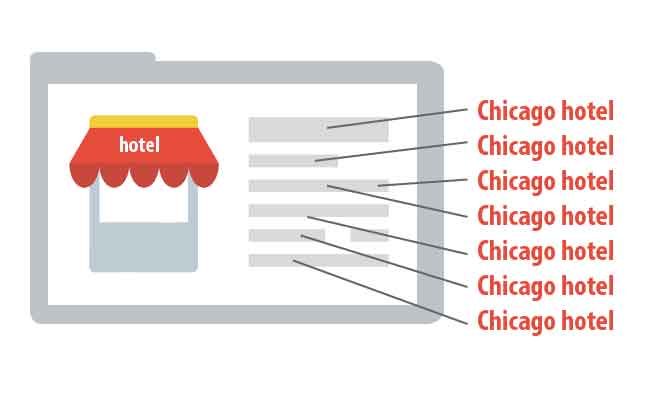
Search Engine Optimization has changed a lot since 2000 and the lot has been changed. Meta keywords have lost their value, page rank is not relevant, keyword stuffing doesn’t help now, and having tons of links wouldn’t help your SEO other but still, we are noticing that people are trying old techniques to optimize their sites, here are most common 10 mistakes which can be avoided and save lots of time and efforts.
1. Keyword stuffing
Purposefully cramming your chosen keywords into the content of your site is, of course, an unethical on-page SEO tactic. But the mistake of accidentally cramming too many keywords into your site could potentially happen. Thankfully, processes like keyword density checks are available and possible to run on your site to make sure you haven’t gone overboard with the keywords. A general rule to avoid your site from being accused of spamming is to produce organic, genuine content that naturally includes your keywords.

2. Using the same title & Description on many pages
Also on account of Google’s SERP limit of 55 characters for title tags and 164 characters for meta description, your method of naming your pages demands consideration. A common mistake that business makes in this area is using the same title and description on many pages. You should make them unique. You can check duplicate assess and meta descriptions and short & long descriptions in your webmaster account.

3. Invisible Text (Content Hiding)
Ever wonder why you don’t see this bad habit much anymore? It’s because search engines penalize it tremendously. Keyword-spamming white-background sites with white text were all the rage back in the early 2000s until search engines started levying heavy penalties. Don’t overuse your keywords. Search engines are smart enough to recognize when your content uses words too frequently. Punishments range from reduced ranking to banning from search results. The key is to keep your content focused and on-topic, and valuable to readers rather than a stream of repeated related words.

4. Not having a title
Forgetting, or completely avoiding the inclusion of page titles is a grave mistake in optimizing your site. There is a surprising number of sites that bear the embarrassing ‘untitled document’ banner in the space where their title should be. Aside from obvious major factors like off-page link building and on-page anchor text, using an effective title tag is largely considered one of the most important steps towards optimizing a site properly. A title tag is considered effective if it holds relevant keywords, this is because titles are a high-priority aspect assessed by Google.
However, while a title tag is very important, over doing it by creating a title that is too long will amount to nothing as it will not fit in the SERP, where Google display only 55 characters.
5. Link Spamming
If you have too many low-quality and irrelevant links, search engines may penalize you for link-spamming. The best way to avoid this is to create compelling content that people will naturally link to. To get the word out, search for “real estate blogs” or “real estate forums” on Google. Post some comments and link back to your site. If your content is compelling, you’ll start seeing organic growth immediately.

6. Load time
Pre-loading screens put people off. Many publishers make the mistake of featuring pages that inform the user that a page is loading and will be with them soon. While it might seem like a polite gesture and a good way of keeping something on the screen, all evidence points to these pages having a negative impact. If you don’t want users to get bored and leave your site, be sure you’ve got a server that’s loading your pages quickly. Avoid telling users what they already know. If they’re waiting then they should know that a page is loading. Seeing the message can make them think they should expect an eternity.
Some awesome page load time tools
- https://gtmetrix.com/
- http://tools.pingdom.com/fpt/
- https://developers.google.com/speed/pagespeed/insights/
7. Improper Naming of Page URLs
An SEO-friendly URL structure is essential for ranking well for the targeted keyword. For example, let’s suppose you have a page on your website selling Gibson electric guitars. Your URL should look something like this: www.yourwebsite.com/gibson-electric-guitars. It should NOT look like this: www.yourwebsite.com/123?adt79.
8. Not adding fresh content regularly
The search engines love new, fresh content on your website. It shows them that your business is still kicking and doing well…separating your website from those here today, gone tomorrow spam websites. Consider adding a blog to your website; it is an easy way to provide fresh content regularly.
9. Not conducting research in a Mobile-Friendly and Fast experience
Not only does SEO optimization deal with keywords and content but also about the quality of the designed website. This is majorly on how it works on mobile devices since the majority of the people have moved to the use mobile devices like smartphones and tablet computers. Google and other search engines can recognize when the website that you have designed is not mobile-friendly. If you forget this your website will not gain online publicity.

10. Writing only for visitors or only for the search engines
SEO copywriting involves targeting specific keywords in your website copy so that it will turn up in the search results when people search the keyword. Unfortunately, typical copywriters write only to the visitor and ignore good SEO techniques. Conversely, too many SEO copywriters get carried away with keyword targeting, and they overlook how humans read and interact with the content. You need a balance of both interesting and effective copy for the visitor and proper content optimization for the engines. Great SEO copywriting both please the search engines and converts human visitors into customers.






